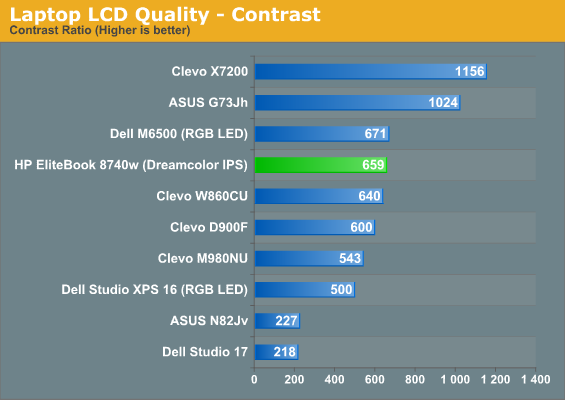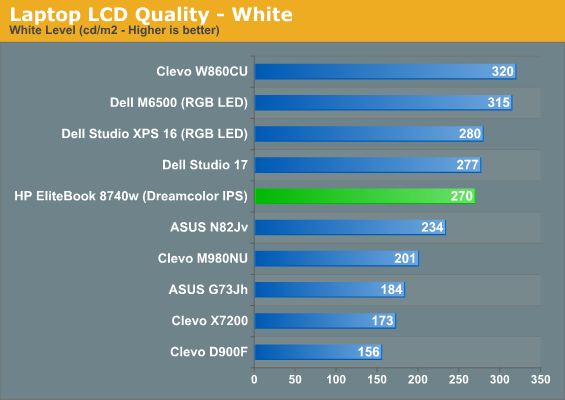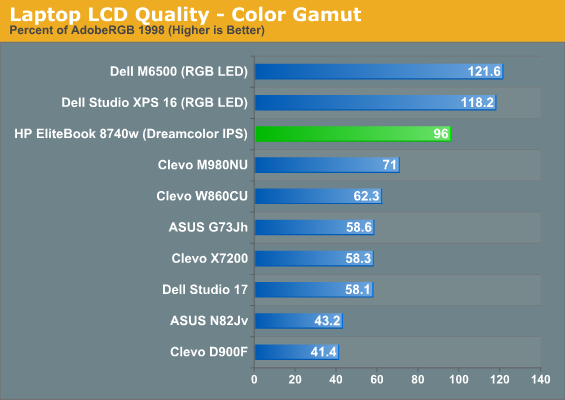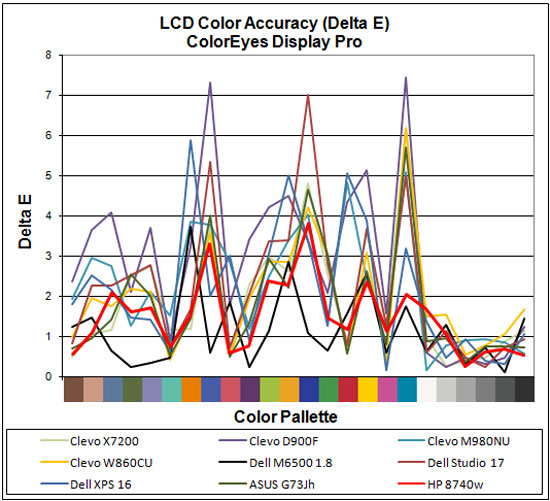HP EliteBook 8740w: IPS on the Go
by Dustin Sklavos on December 8, 2010 3:10 AM EST- Posted in
- Laptops
- IT Computing
- Intel
- HP
- EliteBook
- Mobile Workstation
- Quadro
- NVIDIA
The $550 DreamColor IPS Upgrade
And here we get to the tough part. HP touts the DreamColor matte IPS panel option in their EliteBook 8740w with good reason: it's an IPS panel in a market where anything other than a TN is exceedingly rare. The problem is that it does command a premium, and a massive one: $550 ($570 with the webcam). Dell doesn't charge anywhere near as much for their screen upgrades, so we really want to know if we're going to get what we pay for with the DreamColor.







You asked for an IPS panel, and you got one. The DreamColor produces incredibly accurate color that basically covers the AdobeRGB 1998 color space. Contrast is excellent and of course you get fantastic viewing angles as well. Black and white levels are both quite nice. Overall it's a great-looking panel.
That said, it still has trouble surpassing the Dell notebooks, particularly the Precision M6500, which boasts both superior color gamut and color accuracy by our measure. It gets worse, too: that upgrade to the M6500 is about $200 cheaper...but then it's not IPS. Realistically, few people will need the higher Dell Gamut, but you're still looking at almost twice the upgrade cost to get IPS in place of TN, and we'd say the M6500 RGB LED panel is already priced quite high. $600 can get you a pretty awesome 24" desktop LCD, but a 17" laptop panel with similar characteristics still costs more.
Subjectively it must be said that while the DreamColor panel on the EliteBook 8740w is very attractive and miles away from what we're used to seeing, even after calibration colors can feel oversaturated. 100% Adobe RGB gamut is good for those that need it, but for everyone else working in sRGB color space, that's the penalty. Yes, we're used to seeing dismal, washed out color when testing notebooks, but the 8740w's colors are still too bright at times—and it must be said, the 120% gamut of the M6500 is even worse in this respect. Though our measurements don't totally bear this out, there's definitely some black crush going on as well. I use a calibrated Dell 2709WFP on my desktop, a screen most agree has some issues with oversaturation, and it seems positively mild compared to how bright the colors on the 8740w's DreamColor can be.
Make no mistake, this is a fantastic panel; however, it may not be the game-changer we were looking for, especially not when the Precision M6500 is hanging around. $300 will go from standard LCD to high color gamut WUXGA, but you're still stuck with TN panels; the additional $250 will add the viewing angles that IPS provides. As mentioned in our recent look at an old ThinkPad T42, a good laptop display can be nigh on impossible to find, and HP provides one. It just so happens that the display costs as much as (or more than) a larger 24" LCD that could sit on your office desk.














63 Comments
View All Comments
Dorin Nicolaescu-Musteață - Thursday, December 9, 2010 - link
What is not true, or rather not correct, is saying that having a wider gamut is a penalty and/or a drawback.Remember the days when computers had a Turbo switch? We used it to slow down the programs (mostly games perhaps; Pacman running too fast? :)) that were designed for slower machines, and that were running too fast on newer better computers. Is it correct to say that newer faster machines are worse or the extra MHz are a penalty? Or rather that was a programs' problem?
Same here. Programs or systems that display oversaturated colors on a wide gamut display, are basically not functioning correctly.
Also, regarding "even after calibration colors can feel oversaturated"... calibration, at least on Windows, is a two-step procedure: 1) profile and calibrate display; 2) use color-managed software. There's no point to calibrate the display without using color-managed software and no point to use color managed software without calibration. If you use both as you should, the colors will not "feel oversaturate". In this regard, the statement is false and misleading to those that do not have at least a basic understanding about color management.
JarredWalton - Saturday, December 11, 2010 - link
The problem is that so many applications assume sRGB color space, so if we go by your suggestion that anything that's not color managed is not functioning properly, about the only apps that are "correct" are Adobe Photoshop (and presumably Premiere and a few others). Interestingly enough, Windows Photo Viewer appears to be managed -- i.e. the colors look correct after calibration -- but only if you're not in fullscreen mode. I took some photos in the Dell XPS 15 review a few weeks back comparing colors, and you can clearly see that fullscreen, the B+GR panel in the XPS looks oversaturated, and the older Studio XPS 16 RGB LED looks even more so!a1trips - Wednesday, December 8, 2010 - link
Ahem<Note that HP charges substantially more for a configure-to-order (CTO) system—$5792—but there's an 18% discount code (CTO8740W) to bring the price down to just under $4750, saving you $150. >
not to put too fine a point on it, the math don't work here. so which is it? 18 per-cent
A1
sheltem - Wednesday, December 8, 2010 - link
If you speak directly with an HP rep, you can get a 28% discount, which is what I got back in June.JarredWalton - Wednesday, December 8, 2010 - link
The $150 savings is relative to the $4900 SmartBuy model with the same components. Sorry if that's not clear.OneArmedScissorB - Wednesday, December 8, 2010 - link
Yikes, 49w idle. That's pretty much small desktop + typical laptop TN LED monitor territory, but that's not quite what the hardware is, which raises questions.Any chance that you checked the power with the screen on and off while it was plugged in? I'm curious how much the screen is hurting it there, as every variation of desktop IPS monitors seems to use a bit more than their TN counterparts.
mczak - Wednesday, December 8, 2010 - link
That's a really really hefty enterprise tax you pay there. It is using 4 4GB so-dimms. You can buy these easily for about 60 bucks each nowadays (or 240$ for 4 of them). That's worse than what apple overcharges...(Though I understand there's a premium for 8GB so-dimms, which are nowhere near mainstream, but again it's very ridiculous - more than 2k per dimm...)
mczak - Wednesday, December 8, 2010 - link
Both the gtx 480m and the desktop gtx 465 have 352 cores (11 SM) enabled. The quadro fx 5000m only has 320 cores (10 SM) enabled. Unless you absolutely must have workstation graphics in your notebook, this is very obviously about the worst choice of chip you could order (price, power consumption, not even performance is anything to write home about).nitrousoxide - Wednesday, December 8, 2010 - link
Does it make any sense to test gaming performance on a card designated for mobile workstation? Or Anand doesn't have the test suite for pro cards?JarredWalton - Wednesday, December 8, 2010 - link
Mostly for a point of reference. You'll note that other than running the tests, we didn't spend a lot of time in the intro or conclusion discussing the games. I have to admit that Dustin and I probably aren't the best people to talk to regarding workstation graphics. I had him run the standard SPECviewperf 11 to cover that aspect, but if you have any other tests you'd like to suggest, please let us know.